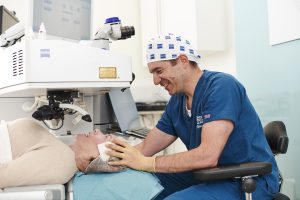Refractive Surgery Then and Now: What’s Changed?

The road to Refractive Surgery as we know it today has been a long one, requiring ongoing research and constant developments. Back in 1990, Laser Eye Surgery had not yet been approved for public treatment, leaving patients to turn to other forms of refractive surgery to correct their visual impairments. We’re taking a closer look at Laser Eye Surgery – then and now – to see exactly how much has changed over the last three-and-a-half decades.
In the early 1990s, Laser Eye Surgery was still the new kid on the block. But before press awareness and celebrity endorsements began to raise the profile of this life-changing procedure, more primitive methods of surgical correction were also still relatively unheard of. Take Susan Singleton, for example, who in 1990 opted to go ahead with a procedure called Radial Keratotomy.
Radial Keratotomy – An Abandoned Procedure
Having suffered her deteriorating sight and the resulting reliance on glasses since the age of 20, Susan read up on Radial Keratotomy (RK) and made up her mind: She would go ahead with the procedure to correct her myopia (short-sightedness).
“I had never got on with contact lenses. At the time I had three children under five – you know what babies are like, they kept grabbing at my glasses and pulling them off!”
RK was developed in Russia in the 1970s and was the first refractive procedure to become popular in the West. It was designed exclusively to correct myopia by changing the refractive power of the cornea. This was achieved by making multiple linear incisions in the anterior cornea which caused the central cornea to flatten, thereby reducing its focusing power.
The Results
At the time of her treatment, one hospital was conducting a trial of the treatment. According to a 1991 Vogue article featuring Susan’s story, the facility “insist[ed] that the only real risk is that patients might be dissatisfied if results yield only a partial improvement in their sight, about one-fifth of patients are said to be disappointed following their operation.”
Fortunately, Susan was one of the reported 80% of patients who were totally satisfied with the results. Her operation was performed in two parts – the first focusing on one eye and the second, performed six weeks later, correcting the other eye.
Still, at the time, Susan was told she could expect to enjoy her new, corrected vision for approximately 20 years when the inevitable signs of presbyopia (ageing eyes) would likely start to set in.
The Next Wave in Refractive Surgery
Eventually, the development of more accurate and predictable treatments – including photorefractive keratectomy (PRK), Laser In Situ Keratomileusis (LASIK), and small incision lenticule extraction (SMILE – also known as keyhole LASIK) – radial keratotomy soon declined in popularity.
The First Laser Eye Surgery Procedures
The earliest of these procedures was rolled out to the public in the UK just one year after Susan underwent her RK surgery. It was the first refractive surgery to utilise excimer lasers – a precise laser used to remove areas of the corneal tissue, adjusting the eye’s refractive power.
Soon after the rollout of PRK and another surface procedure known as Laser-assisted subepithelial keratectomy (LASEK), both of which involve removing a portion of the corneal epithelium in order to gain access to the tissue beneath, LASIK was introduced.
Unlike PRK and LASEK, LASIK involved creating a small flap in the surface of the cornea which could be put back in place once the correction was complete. This made for a less invasive procedure and improved recovery times. LASIK remains the most commonly performed Laser Eye Surgery procedure to this day.
In the early days, these procedures involved the use of a tiny oscillating blade known as a microkeratome to create the necessary incisions in the corneal surface. However, following the introduction of the femtosecond laser in 2001.
The Latest Revolutions in Laser Eye Surgery
Despite the success of bladeless LASIK (tens of millions of patients have undergone the procedure), developments in Laser Eye Surgery have not stopped. In fact, since the introduction of LASIK over 30 years ago, there have been some significant advancements in Laser Eye Surgery, perhaps most notably in the form of ReLEx SMILE and PRESBYOND® Laser Blended Vision.
The latter – an innovative treatment for presbyopia – was introduced just in time for Susan who, as promised, eventually found herself in need of reading glasses. Of course, having had the RK procedure (which involves cuts of 90% depth in the peripheral cornea, weakening the area), Susan wasn’t sure she would be a candidate for blended vision. Thankfully, as it turned out, she had nothing to worry about!
PRESBYOND® Laser Blended Vision for Presbyopia
PRESBYOND® is a technique that was first developed by our very own founder and expert laser eye surgeon, Professor Dan Reinstein – who, incidentally, also helped to develop the MEL80 and MEL90 femtosecond lasers!
Laser blended vision involves correcting each eye differently. One eye is corrected for distance vision with a little near vision while the other eye is corrected mainly for near vision with a little distance vision. This technique creates a “blend zone” through which the brain is able to process clear vision across all distances!
To this day, it remains a revolutionary approach to presbyopia – and refractive correction, in general. It is highly tolerated – as Susan discovered for herself – being suitable for up to 90% of patients!
If you’d like to learn more about the revolutionary treatments available at the London Vision Clinic, get in touch with one of our friendly clinic coordinators or Book a Consultation today!


